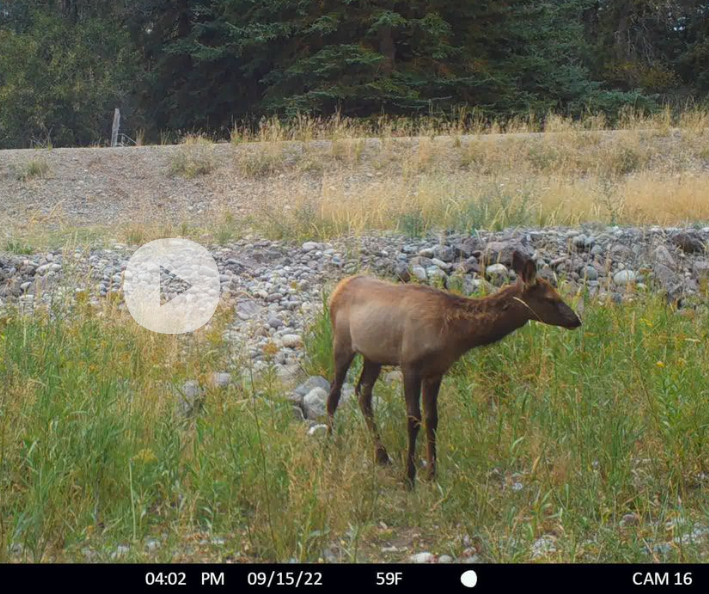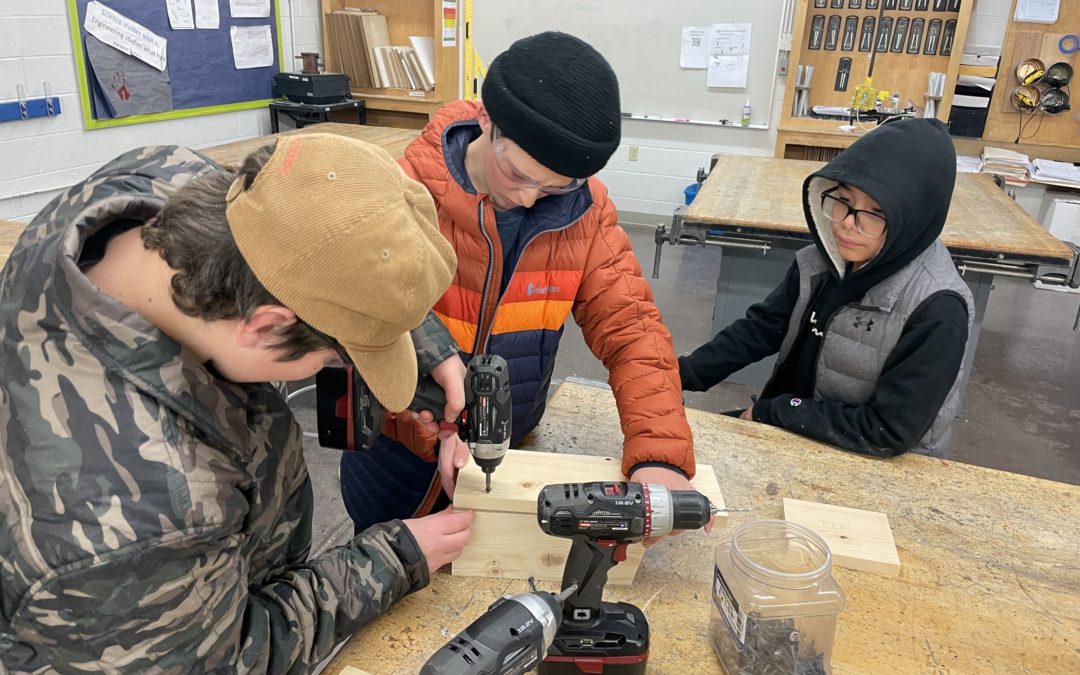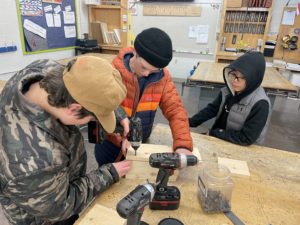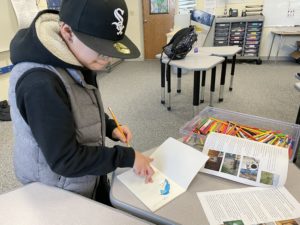
Moose Day 2023 Unofficial Report
By Frances Clark
Compared to last year, as Anne Kirkpatrick noted: “Beautiful morning at a balmy 26° compared to last year’s minus 12° temps.”
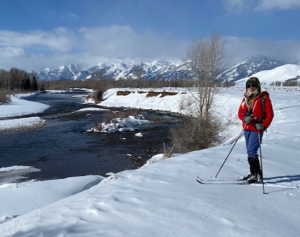
Photo by Betsy Murphy
“North Leigh Creek was amazing! It was very peaceful out there and it was such a treat when the sun made an appearance.” Kristy Smith
In Wilson it was a “lovely warm day, 22 degrees at 9 am, 30 degrees just after noon. Windy off and on.” – Unattributed
However, there were deep-snow conditions for skiers/snowshoers:
Barb Cassells’ team of four cross-country skied the Gros Ventre campground – “We split up and it took us 3.5 hrs just to cover the campground because we were breaking trail in 4 feet of deep snow…. Slow and arduous going.”
“Off trail the snow, particularly the snow that fell over the past couple of days, was too soft and deep to travel on.” Gene Linn
“…route was pretty heavy slogging through mostly calf-deep snow. It was good that there were four of us as we were able to rotate the trail-breaker role frequently. We’re not sure that a team of two would have been able to make it all the way to the end of the survey zone.” Sue Rope
And it was tough for moose, too:
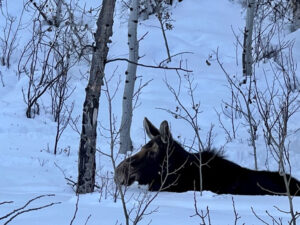
photo by Betsy Murphy
Loren Nelson: “We have never seen so much snow in the high residential areas of Jackson. The piles were 8-12 feet almost everywhere and I can’t imagine how any wildlife can get around.”
Steve Squalluci who surveyed areas west of the airport: “We saw no Moose! I’m thinking because of the 3 to 5 feet of snow they are staying in the river valleys.”
Where were moose found?
We don’t have the maps yet, but by reviewing the data, here are some general locations:
Few were seen in Jackson, on the buttes, or in the southern subdivisions, but many were in Wilson and the West Bank. They were recorded in some numbers along the bottomlands of the Snake River, the Gros Ventre River, Pacific Creek, and Buffalo Valley – where there is cover and willows/cottonwoods.
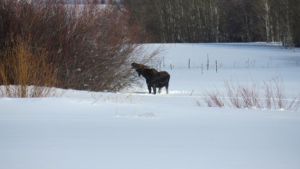
photo by Linda Unland
Some got pretty close accidentally:
Matt Fagan reported: “I had just crossed Pacific Creek to the west side and was putting my skis back on. Saw, but did not hear, a moose moving away from me quick and easily into heavy timber, maybe 20 yards or less away. Moose was in a daybed and I spooked it….As I was floundering in the snow, it was impressive how quickly this moose moved. I did not pursue.
Sign/tracks were abundant:
Several people noted tracks and scat of moose and tried to find the moose.

photo by Kathy McCurdy
For instance: at the north end of park: “Moose tracks were visible in the Willow Flats area, south of Jackson Lake Lodge. We did not see that animal.” EcoTours group.
“None actually seen but the fresh tracks of at least three moose were observed, two north of the Emily’s Pond Trail and one just south of R Park near the tunnel.” Susan Marsh
And south along the dike: “One fresh moose bed with poop and hair in it. Tracks leading in multiple directions from bed.” Sue Rope
West side of the Tetons: “We saw quite a few moose tracks. It was difficult to determine if the tracks were from a single moose traversing the road, or from a different moose…. note of tracks when I was quite sure it was a different set of tracks coming from a different direction.

photo by Sue Rope
“We failed to ‘see’ any moose, but one crossed our tracks and left its tracks between the time we skied up South Leigh Canyon and when we returned. So we know there is at least one moose in the canyon.” Fred Johnson
The Fish Creek team finally saw some tracks but no moose up a side road just before the noon deadline. They were driving back down the hill, only to be blocked by a stuck FedEx truck. While the FedEx driver spun his wheels, two surveyors found a cow and calf nestled under a tree. Then the three women (average age 72) dug out the truck’s rear wheels so when a husband came to chain the truck and straighten out its rear, FedEx could continue on its way. Triumphs of the day.
No Moose:
The report by Beverly Boynton who skied the vicinity of Ditch Creek is telling: “No moose, no moose tracks, no moose beds, no moose scat. No other birds or mammals, except heard a chickadee at one point; moderate number of pine marten, squirrel, and mice tracks…. looking at moose size nooks and crannies…trail breaking was ok,… We tried to stay on wind slabs, which was easy enough to do. I wonder if areas that had moose also had less wind slabs, i.e. softer snow?”
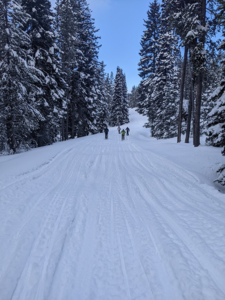
photo by Fred Johnson
A third (14 out of 42) of the teams did not find any moose despite hours of careful scouting.
Again to emphasize, “0” moose is great data. Thank you!
Other critters:
Other wildlife sightings on Moose Day are important too: Here are just a few mentioned.
People observed winter regulars: red squirrels, chickadees, cross-bills, mule deer, bald eagles, and white-breasted-nuthatches. Several teams saw elk: Sarah Dewey and Carson Butler of GTNP scouted over 100 in Buffalo Valley and south; Bruce and Nancy Pasfield saw elk and mule deer during their “breathtaking” ski around the Snake River Sporting Club; and the Fish Creek team saw several elk among some houses and fields.
Scouts along the Snake River north of the Wilson bridge added a trumpeter swan, 40 Barrows goldeneyes, 12 mallards, and a belted kingfisher. The Fish Creek team saw 2 dippers, 2 mule deer, and mallards in Fish Creek. The Hosted Moose Day team up Cache Creek had a nice assortment of birds: hairy woodpecker, lots of red crossbills, Townsend’s solitaire, pine siskin, common raven, brown creeper, mountain and black-capped chickadees, red-breasted nuthatch, and dark-eyed junco.
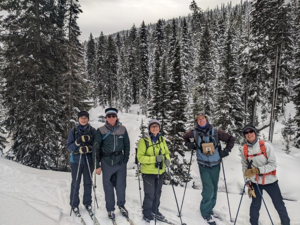
photo by Fred Johnson
Kristy Smith and Josh Holmes up North Leigh Creek logged 2 Bohemian Waxwings as well as a “pile of feathers from some type of grouse that had an unfortunate encounter with some unknown predator (no wing marks so we figured it was not a raptor).”
East of Kelly, the USFS team on snowmobiles observed 5 wolves.
“Our favorite sighting for the day was a romp of otters feeding on trout near the oxbow bend. They are always a crowd pleaser! We finished our moose day with tasty moose bread from Dornan’s. Thank you very much!” Laura, Tyler, and Dylan volunteers from Jackson Hole EcoTour Adventures.
Your sightings and keen observations are terrific. If you haven’t added your Moose Day sightings, please do under Casual Observations.
Changes/Concerns:
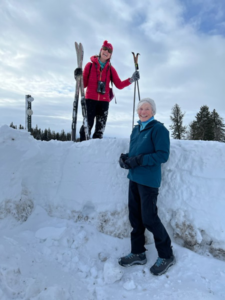
photo by Charlotte Kidd of Kathryn Turner and Larrie Rockwell
“Surprising that the moose are not in Karns Meadow but we have only seen one in the meadow all winter! Maybe next year.” Loren Nelson, neighbor
Reade Dornan reported: “About 60 snowmobiles at the far end of the Gros Ventre Road above Slide Lake…were amassed and about to take off. I could see why the moose are no longer visible up there. They’ve probably receded into the side canyons away from the noise and chaos along the Gros Ventre River. Really upsetting…. We saw almost no birds, not even the ouzel that was ALWAYS available off the Kelly bridge to the TV Ranch, at least in the old days.”
Fred Johnson who skied up South Leigh Creek: “As with last year, due to the very heavy use of this canyon by snowmobiles to provide access to skiing on Beard’s Mountain, … We assume moose and other wildlife prefer to live somewhere with less human activity.”
The Nature Mapping data we all collect helps inform management decisions of our public lands.
Fun meeting people and old friends:
Almost 30 people gathered at the Snake River Brew Pub for lunch. Many of the comments included the fun they had being together and new friends made.
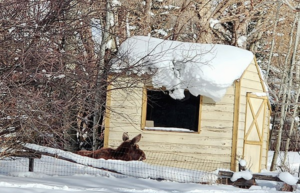
photo by Kate Gersh
“Great to meet folks at the Brew Pub afterwards. It was fun to contribute.” Sue Rope
Hosted Moose Day, a special educational opportunity attracted 15 people who hiked with JH Wildlife Foundation’s Kyle Kyssock and Hilary Turner for 4 miles round trip up Cache Creek to find 2 moose: “We had great camaraderie amongst the group with several visitors traveling from Salt Lake, Rexburg, and Idaho Falls for the sole purpose of participating in Moose Day and other visitors from as far as Florida and New York who came to Moose Day as part of their winter vacation to the area.”
Special thanks:
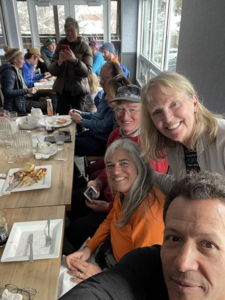 We had staff participation from several agencies: Grand Teton Nation Park, U.S. Forest Service, Wyoming Game and Fish Department, and Teton Conservation District. Tour companies also provided volunteers: JH EcoTour Adventures, Buffalo Roam Tours, and Vintage Adventure’s Tipi Camp. Several Teton Regional Land Trust staff scouted the canyons on the west side of the Tetons.
We had staff participation from several agencies: Grand Teton Nation Park, U.S. Forest Service, Wyoming Game and Fish Department, and Teton Conservation District. Tour companies also provided volunteers: JH EcoTour Adventures, Buffalo Roam Tours, and Vintage Adventure’s Tipi Camp. Several Teton Regional Land Trust staff scouted the canyons on the west side of the Tetons.
We also greatly appreciate permission to survey private lands: Snake River Ranch, Astoria Hot Springs, Snake River Sporting Club, the Morgan family; HOA’s of John Dodge, Aspens, Pines, West Gros Ventre Butte, Spring Creek Ranch, JH Golf and Tennis, Teton Science School, Indian Springs, and others. Without their support, we would not survey moose on these private properties.
Total effort is Impressive:
We had a total of 139 volunteers in 42 teams: 34 teams on the traditional east-side areas, and 8 teams from Teton Valley on the west side of the Tetons. Total effort added up to: 382.75 hrs: ski = 195.25 hrs; car = 152.5 hrs; walk = 18.75 hrs; snowmobile = 6 hrs.
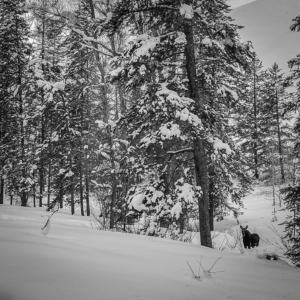
photo by Morgan Graham
We had ski teams in all corners of the count area persevering through deep-snow conditions. Particularly notable were the teams on the west side of the Tetons who intrepidly skinned, skied, and snowshoed miles up the canyons—all relatively new areas for Moose Day.
The effort prize, if we had one, would likely go to JHWF Executive Director Renee Seidler with two partners who booted up from Teton Pass to Glory Bowl, skied down Coal Creek, skinned up Trail creek to Mail Cabin and skied back to the road. They tallied 4,500 feet of elevation gain and loss. Their effort will determine a better outline of the Coal Creek area for future surveys.
Organizational skills were welcomed: John McMorrow deployed a team of 11 on the Snake River Ranch. Teams of 5-6 were set in motion by Peyton Giffin, Fred Johnson, and AJ DeRosa.
We also acknowledge the teams who meticulously drove up and down the intricate streets of Jackson and the mazes throughout subdivisions. Fortunately, no moose were seen in Jackson as downtown is not good or safe moose habitat. Areas around Wilson were frequent moose haunts. Moose were generally scattered south of Jackson—so these careful car surveys are important!
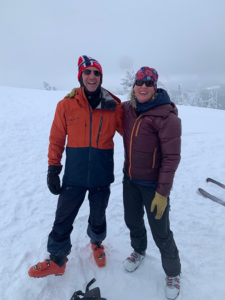
photo by Dan Bernstein – top of Glory
And hats off to those who drove by car and scaled snowbanks for better views.
And for some, Moose Day was a family outing. Steve Squallucci and his wife were accompanied by their two grandchildren. The Linn family and friends scouted the family compound and adjacent areas by snowshoe and ski.
Long-timers Leith and Barbara Barker carpooled with Reade and Dave Dornan. “The Dornans love these rituals with the Barkers. We love getting out and comparing notes with old friends. We love gossiping and talking about the importance of caring about our wildlife.”
Total Moose:
The unofficial count is 97-98 moose…maybe 100…Aly Courtemanch and Hilary Turner need to check some possible duplicates and also review photographs of tracks to determine their freshness.
Finally:
Thank you all for your extraordinary efforts to seek out moose on a lovely morning. The terrain was challenging for both people and moose. It will be very curious to compare the counts, but also the locations of moose this year compared to previous years given the conditions. All this information helps wildlife managers provide guidance for moose and opportunities for each of you to share your stories with friends.
Together we care for moose!
Sincerely,




